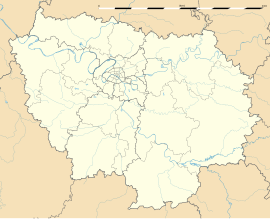world.wikisort.org - France
Marly-la-Ville (French pronunciation: [maʁli la vil] (![]() listen)) is a commune in the Val-d'Oise department in Île-de-France in northern France, 25 km north of Paris.
listen)) is a commune in the Val-d'Oise department in Île-de-France in northern France, 25 km north of Paris.
Marly-la-Ville | |
|---|---|
Commune | |
 The town hall of Marly-la-Ville | |
 Coat of arms | |
Location of Marly-la-Ville  | |
 Marly-la-Ville  Marly-la-Ville | |
| Coordinates: 49°04′54″N 2°30′01″E | |
| Country | France |
| Region | Île-de-France |
| Department | Val-d'Oise |
| Arrondissement | Sarcelles |
| Canton | Goussainville |
| Intercommunality | CA Roissy Pays de France |
| Government | |
| • Mayor (2020–2026) | André Specq[1] |
| Area 1 | 8.62 km2 (3.33 sq mi) |
| Population | 5,663 |
| • Density | 660/km2 (1,700/sq mi) |
| Time zone | UTC+01:00 (CET) |
| • Summer (DST) | UTC+02:00 (CEST) |
| INSEE/Postal code | 95371 /95670 |
| 1 French Land Register data, which excludes lakes, ponds, glaciers > 1 km2 (0.386 sq mi or 247 acres) and river estuaries. | |
History
Thomas-François Dalibard lived at 15 rue du Colonel Fabien, a classical eighteenth-century mansion. He was a naturalist and a disciple of Georges-Louis Leclerc de Buffon. He translated and published the works of Carl Linnaeus thus introducing Linnaean nomenclature in France. Also a devoted physicist, he tested the experimental ideas of Benjamin Franklin at his house, completing the first capture electrical charge from lightning. Thus, the lightning rod was born at Marly-la-Ville.[3]
Population
| Year | Pop. | ±% p.a. |
|---|---|---|
| 1968 | 1,987 | — |
| 1975 | 2,419 | +2.85% |
| 1982 | 5,078 | +11.18% |
| 1990 | 5,128 | +0.12% |
| 1999 | 5,696 | +1.17% |
| 2007 | 5,549 | −0.33% |
| 2012 | 5,531 | −0.06% |
| 2017 | 5,677 | +0.52% |
| Source: INSEE[4] | ||
See also
References
- "Répertoire national des élus: les maires" (in French). data.gouv.fr, Plateforme ouverte des données publiques françaises. 13 September 2022.
- "Populations légales 2019". The National Institute of Statistics and Economic Studies. 29 December 2021.
- Cf. En pays de France, op. cit., p. 483-484.
- Population en historique depuis 1968, INSEE
External links
- Official website (in French)
- Base Mérimée: Search for heritage in the commune, Ministère français de la Culture. (in French)
- Association of Mayors of the Val d’Oise (in French)
Wikimedia Commons has media related to Marly-la-Ville.
На других языках
[de] Marly-la-Ville
Marly-la-Ville ist eine französische Gemeinde mit 5663 Einwohnern (Stand: 1. Januar 2019) im Département Val-d’Oise der Region Île-de-France; sie gehört zum Arrondissement Sarcelles und zum Kanton Goussainville. Die Einwohner werden Marlysien(ne)s genannt.- [en] Marly-la-Ville
[ru] Марли-ла-Виль
Марли-ла-Виль (фр. Marly-la-Ville) — муниципалитет во Франции, в регионе Иль-де-Франс, департамент Валь-д'Уаз. Население — 5 729 человек (1999)[2]. Муниципалитет расположен на расстоянии около 28 км северо-восточнее Парижа, 33 км восточнее Сержи.[3]Текст в блоке "Читать" взят с сайта "Википедия" и доступен по лицензии Creative Commons Attribution-ShareAlike; в отдельных случаях могут действовать дополнительные условия.
Другой контент может иметь иную лицензию. Перед использованием материалов сайта WikiSort.org внимательно изучите правила лицензирования конкретных элементов наполнения сайта.
Другой контент может иметь иную лицензию. Перед использованием материалов сайта WikiSort.org внимательно изучите правила лицензирования конкретных элементов наполнения сайта.
2019-2025
WikiSort.org - проект по пересортировке и дополнению контента Википедии
WikiSort.org - проект по пересортировке и дополнению контента Википедии